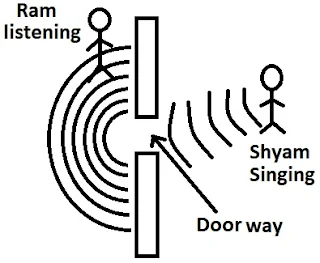X - Ray Diffraction, Electron Diffraction and Neutron Diffraction
What is Diffraction?
Consider two friends Ram and Shyam sitting in two different rooms separated by walls and doors. Ram can listen Shyam singing though they can't see each other.
Ram and Shyam can listen to each other because sound waves undergo diffraction.
The bending (waves don't always travel in straight lines) and spreading of waves as they pass through narrow opening or pass by the edges of opaque bodies is called the diffraction.
Image Credit: By Verbcatcher - Own work, CC BY-SA 4.0, https://commons.wikimedia.org/w/index.php?curid=68991367
In the above figure water waves diffract as they pass through a narrow entrance.
Diffraction occurs only when the wavelength is closer to the size of the opening or object. Sound waves diffract easily because their wavelengths are larger and comparable to the door opening. But the light waves having very small wavelength need very small slit to undergo diffraction.
X -Ray Crystallography (XRC) or (XRD for X-Ray Diffraction)
This is an experimental technique for determining the structure of the crystalline substances (in which the atoms or molecules or ions are orderly arranged in a definite pattern). The beam of incident X ray is diffracted in many specific directions by the orderly arrangement of the constituent particles. The angles and intensities of the diffracted beams are measured to find the three dimensional distribution of the density of the electrons in the substance, which in turn gives the mean position of the atoms in the substance. This can also help in determining the bond length, crystallographic defect, size of atoms, ionic radii, structure of minerals, alloys, DNA, protein, drugs, vitamins etc.
In X ray diffraction, diffraction tales place from the atomic planes of the interacting crystalline substance.
Image credit: Hydrargyrum, CC BY-SA 3.0 <https://creativecommons.org/licenses/by-sa/3.0>, via Wikimedia Commons
In electron diffraction, a beam of electrons interact with the atoms and molecules and this technique is primarily and especially used the study of crystal structure.
In neutron diffraction, the beam of neutrons interact with the nucleus of the substances and help in the determination of atomic and magnetic structure.





Thank you sir. Add more details please
ReplyDelete